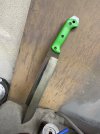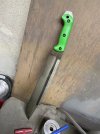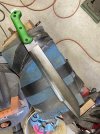Bill Siegle
Knifemaker / Craftsman / Service Provider
- Joined
- Oct 3, 2000
- Messages
- 6,418
Over the years
 not2sharp
has several times encouraged me to make a Predator Machete. I’ve resisted due to not being ready to take on the grinds and most importantly the large heat treating challenge. Well the other day I decided to try my hand at it
not2sharp
has several times encouraged me to make a Predator Machete. I’ve resisted due to not being ready to take on the grinds and most importantly the large heat treating challenge. Well the other day I decided to try my hand at it  I used BK&T scales to speed things along and because quite honestly, they’re AWESOME grips! I used 1/4in 5160 for blade stock. All the bevels and some tang drilling, got weight down to a very functional 30oz. The blade is 14 7/8in tip to scale and 20 5/8in overall. I ground the spine to “almost sharp”. The clip is not sharpened either. I may change that later but for now the cool lines are enough
I used BK&T scales to speed things along and because quite honestly, they’re AWESOME grips! I used 1/4in 5160 for blade stock. All the bevels and some tang drilling, got weight down to a very functional 30oz. The blade is 14 7/8in tip to scale and 20 5/8in overall. I ground the spine to “almost sharp”. The clip is not sharpened either. I may change that later but for now the cool lines are enough  I’m really happy with how this feels in the hand! It’s no light weight grass slasher but it is definitely a very usable tool especially for northern climates.
I’m really happy with how this feels in the hand! It’s no light weight grass slasher but it is definitely a very usable tool especially for northern climates.






Last edited:

